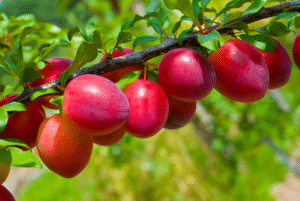There are many advantages to an edible garden, fruit trees are colorful and can grow quite large to provide shade, and they can also save you trips to the grocer and shave a little off your shopping bill. There is a certain satisfaction to growing your own fruit, and you know what you are eating is fresh and free of pesticides and chemicals!
There are fruit-bearing trees suitable for any climate and size of garden so let’s take a look at the five most popular options for you to choose from. And if you have questions, contact Amico – the experts gardeners in Sydney if you would like any more information about adding a fruit bearing tree to your garden.
1. Apple trees
It makes sense that we would put the most popular fruit tree first, as who doesn’t love a delicious juicy apple! Apple trees are highly requested by budding gardeners and are best suited for colder, temperate climates.
The main component for a fruitful apple tree is fertile soil that is kept relatively moist. For your topsoil, aim for a depth of around two feet and make sure it is not in a position where water will drain away too quickly.
A special effect for the dwarf varieties is that they have the ability for wall training, which means you don’t need a huge space to have an apple tree either. If you would rather have a dessert apple, it will require a significant amount of sun as opposed to cooking apples which can handle more shadier areas.
It is best to plant apple trees in the dormant season with a lot of mulch and ensure you water them well when they first go in the ground and the time after that. Depending on the variety of apple tree you have chosen you should see fruit within a few years.

For apple tree topsoil, aim for a depth of around two feet and make sure it is not in a position where the water will drain away too quickly.
2. Plum trees
Another excellent option for cooler temperate climates is the plum tree. A word of warning, however, expect a significant amount of plums if these trees are kept in fertile soil and well watered. Much like the apple tree, it is best to keep them well mulched and in an area where water doesn’t drain away too quickly.
There are varieties of plum trees that can grow in containers to suit smaller spaces and courtyards, but those with more room may opt for a version that will grow much larger.
Important note: Before purchasing, check if your chosen plum tree is self-fertile, if it’s not you will need more than one tree to ensure you see some fruit.

Much like the apple tree, it is best to keep them well mulched and in an area where water doesn’t drain too quickly.
3. Cherry trees
For something a little different, you may like to consider a cherry tree! Once again these are great for spaces of all sizes as they can be grown as free-standing trees or they have the ability to be trained against a wall.
If you decide to choose the sweet cherry variety, you may need more than one tree for fertilization, and they will need to be kept in full sun. Bitter cherries on the other hand are the opposite, they are self-fertile and able to be kept in the shade.
The other benefit to cherry trees beside their delicious fruit is the beautiful blossoms that will grow on the tree adding colour to your garden area.

Cherries are great for spaces of all sizes as they can be grown as free-standing trees or they have the ability to be trained against a wall.
4. Pear trees
If you are looking for an easier to manage tree with low maintenance, the pear tree is the one for you! Choose between either a sheltered or sunny spot and either stand-alone or as part of a forest garden.
Depending on which variety of pear tree you choose, it should begin growing fruit within a few years. Once it has established itself, it is very durable and self-sufficient.

Great for either a sheltered or sunny spot and either stand-alone or as part of a forest garden.
5. Peach trees
Peach trees don’t handle the frost too well in cooler climates, they are better suited for a sunny, sheltered spot. They can, however, be grown in containers if your space is small or if you want to bring them inside during the colder parts of the year.
If you do decide to grow your peach tree in a container, ensure it is at least 45cm wide and only plant the dwarf variety. Once again these trees can be trained against a wall and may require hand pollination to see fruit.

If you do decide to grow your peach tree in a container, ensure it is at least 45cm wide and only plant the dwarf variety.
Turn your backyard into your grocer!
Planting fruit trees are great, not only for the colour that they bring to your garden, but they return to you a few items that you can scratch off the grocery list!
If you give them the time and patience they need to establish themselves, you’ll be rewarded with fresh, delicious fruit that you have grown yourself for many years to come!


No Comments